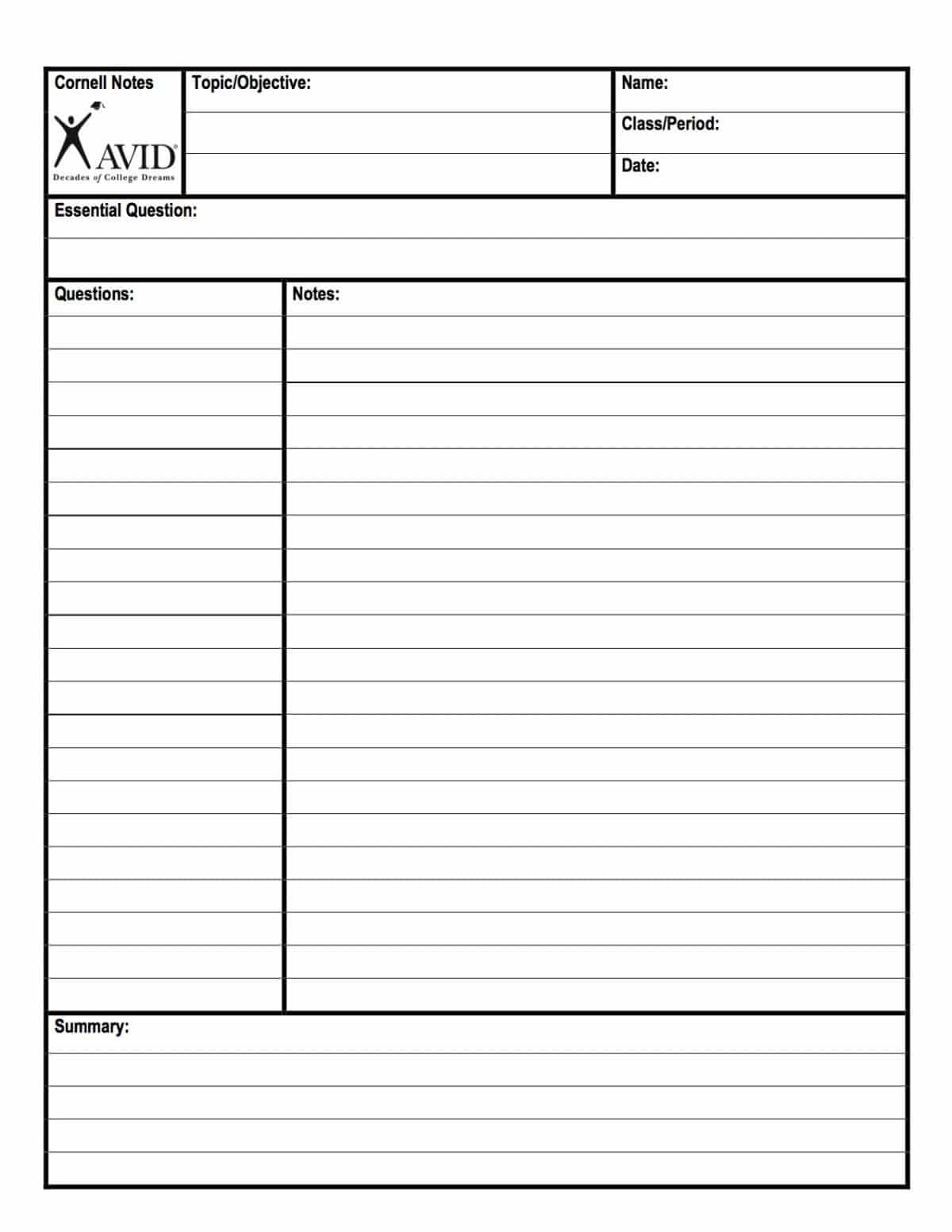The Cornell note-taking system is designed to have students play a more active role in synthesizing and retaining information. You can start using a Cornell notes template in your classroom to prepare students for college or simply help them retain information more efficiently.
A Guide to Implementing the Cornell Note-Taking System in Your Classroom
The Cornell note-taking system was invented in the 1940s by a Cornell University professor named Walter Pauk. This system is designed to have students play an active part in structuring the information they learn in class. Here is how you can implement this note-taking methodology in your classroom.
The Benefits Of The Cornell Note-Taking System
The Cornell notes template is designed to organize information. This methodology requires students to go over their notes after each class so they can create a summary and add information in the study cues column.
This encourages students to play a more active role in the learning process. It’s a simple system that is easy to adopt.
There is a visual element that will help students retain information. This approach also helps students apply what they learn and develop strong synthesizing skills, which will be very valuable in college.
What Does The Cornell Notes Template Look Like?

You can easily find a Cornell notes template online or teach your students to create one. All you have to do is separate a page in four sections with a shape that resembles a capital I. Keep in mind that the left-side column should be smaller than the right-side column.
You can easily adapt this template as needed. For instance, you could create an additional section for students to write down the new words they encounter during a lesson if you teach a foreign language.
Make sure students have a template ready ahead of a lesson so you can start right away with the lesson and have students take notes.
How To Use The Cornell Note-Taking System
The small section at the top of the page should be used to write down a few things about the lesson. Students might need to write down the name of the course, date, and the topic of the lesson. Let each student develop their system to keep track of their notes.
The right-side column is used to take notes during classes. This is something students should already be familiar with. Encourage them to develop their own system to keep track of what is important. You could recommend that they use different colors or underline important information.
At the end of each lesson, students should go over their notes and add some questions in the right-side column. These questions should help them go further and connect the material with other lessons. Finding some questions that will help them explore the topics discussed and go further will help them process the new information.
The left-side column of the page is the study cues column. This is a column students will need to fill out after each lesson. The purpose of the study cues is to summarize the main ideas and important concepts from the notes. Students should be able to hide the right-side column and use the study cues to recite the content.
Study cues should guide students as they learn and recite new material. Let students create their study cues since everyone has a different way of retaining new information.
The bottom section of the page is the summary section. Students should write a summary after going over their notes. Creating a summary helps students learn new information and retain it. The summaries will be helpful when students need to brush up on old material quickly.
Tips For Implementing The Cornell Note-Taking System

Using a Cornell notes template will help high school and college students. Younger students might not benefit from it. You can introduce the system in your classroom as long as students are used to taking notes on their own.
You might want to focus on introducing different methodologies to help your students take notes during lessons first. The additional elements introduced by the Cornell note-taking methodology might overwhelm students if they are struggling with taking notes.
The summary section of the template shouldn’t be an issue since students are used to synthesizing information. The study cue column will probably be the most difficult element of this methodology.
The study cue column should be unique to each student. However, you shouldn’t hesitate to provide a short list of key concepts that should appear in the study cue column if your students are new to using this methodology.
Extracting the most important study cues from the notes will become easier as students get used to using the left-side column to recite their notes. This will help them identify which cues are going to help them recall information.
Use these strategies to help your students adopt the Cornell notes template in your classroom. Don’t expect your students to change the way they learn things overnight. Set some realistic goals and focus on having students change their attitude towards learning and play a more active part in it by the end of the school year.
Introduce The Template Early In The School Year
It takes time for students to get used to finding the right study cues when going over their notes. Using this methodology also means that students will need to make time for going over their notes after each lesson.
It is best to introduce the Cornell note-taking methodology as early as possible in the school year. Students will have to organize their time right away to go over the notes after each lesson. Your students might not get all the benefits of this methodology right away, but they will have a new way to retain information by the end of the school year.
It will also take time for students to learn to come up with insightful questions to add to the right-side column and to figure out what to add to the study cues column. Don’t despair if these sections seem empty at the beginning of the school year!
Give Students Time To Go Over Their Notes In Class
Your goal should be to get students to go over their notes independently as early as possible in the school year. However, you should give them some time in class to go over their notes.
This is a great way to make sure everyone understands how the system works and it helps students get into the habit of going over their notes, asking questions, and finding study cues.
You could end each lesson by creating a summary together. The students who are behind with their synthesizing skills will get a better idea of how to extract important information from their notes.
Even though study cues should be unique to each student, you can have students share the study cues they have decided to use. This will help other students fill out this column if they have a hard time with identifying which important concepts should be added.
You could also make some time to have students come up with questions and ask them at the end of each lesson.
Assignments
You can turn the Cornell note-taking system into an assignment. This approach will help you save time in class and will help students get into the habit of going over their notes after each lesson. This could be a great way to help high school students get ready for college.
Dedicate a few minutes to checking the notes from the previous lesson at the beginning of every class. Make sure that every student took the time to write a summary, find study cues, and added some questions to their notes.
You could also have students come up with their questions and do some research to answer these questions as an assignment.
Another way to use this system as an assignment would be to pick a student at the beginning of each class, have them cover the right-side column of their note, and go over what was covered during the last class with the help of their study cues.
Encourage Reflection
Another advantage of this methodology is that it encourages students to connect new information with what they have already learned. Make sure you provide students with opportunities to make these connections.
Give students opportunities to give their notes and draw on previous knowledge when completing assignments or working on different activities in the classroom.
Everything you do in the classroom should be geared towards having students adopt a more active attitude. Encourage them to ask their questions and to find the answers by themselves. This is the kind of attitude that will help them succeed in college.
You can also find new ways to check on what students have learned. Let them keep their notes and ask some questions about material from previous lessons. The goal is to find the answer as quickly as possible in one’s notes!
The Cornell note-taking system is going to change the way your students think about learning. This methodology encourages students to be more active and to ask more questions. Try introducing it as early as possible in the school year, and make sure you dedicate enough time to helping students write good summaries and find helpful study cues.

